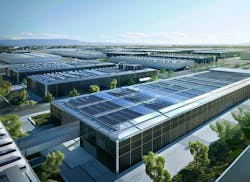Future-Proofing AI: A Blueprint for Success
In a world where Artificial Intelligence and high-performance computing are reshaping industries, the potential for data centers to become the backbone of tomorrow's technological advancements is immense. Modernizing designs and operations and integrating advanced technologies can transform data centers into powerhouses ready to support AI training, large language models, and generative services.
However, investing significant time and resources in partial solutions that can only cater to today's needs, or a specific deployment type, one-chip design, or cooling approach is more than a severe limitation in meeting your customers' AI requirements. It also puts you at risk of lagging behind in the rapidly evolving technological landscape. A limited solution means you're tied to today's technologies and will inevitably miss out on tomorrow's advancements, as by the time a new data center is operational, it will already be outdated.
Adopting a proactive approach not only future-proofs operations but also paves the way for a future of unparalleled technological progress. AI, Machine Learning, and other High-Performance Computing services are set to require gigawatts of new capacity in the coming years, with densities rapidly scaling well into the triple digits. This surge in demand will inspire accelerated innovation, diverse designs, and massive upgrades in speed, storage, and scale. However, data centers that fail to keep up with this pace of change will risk missing hosting many of the largest deployment opportunities of the next decade.
These new deployments will require data center providers who embrace innovation, flexibility, and economies of scale and recognize the importance of sustainability in the face of gigawatt-level facilities and campuses. So, what does a smart, forward-looking data center platform need to deliver for AI and other HPC customers? The answers may seem simple to list but more challenging to turn into reality.
- Flexibility: Put simply, the traditional approach of building a shell, bringing in power and networks, adding adequate cooling, and waiting for customers to install IT equipment is a limiting approach when AI is the priority. Data center designs will need to meet some extremely specific power, cooling, and processing requirements from customers, and those needs may change from project to project and from location to location, even when building multiple sites for a single customer. As a result, flexibility is a critical consideration for every facet of future data center design.
- Avoid Technology Lock-In: The data center industry is experiencing change at an unprecedented pace. In the future, as competition and innovation intensify among chip makers and server manufacturers, data center providers will need to accommodate an assortment of power requirements, cooling options, rack designs, and server specifications, often in a single data center. They must plan for tomorrow’s solutions to look very different from today’s.
- Scalability: The data center you build to support AI training or modeling might look quite different from what you build for an AI inference engine. AI customers already know this, and they expect you to be able to design solutions that are the right size, with the right power, in the right locations. Some data centers might be exceptionally large but do not require proximity to population centers. Others may have a much smaller footprint but require network access to serve millions of users in and around major markets. Designing to scale and location is essential for any data center provider working with AI-oriented customers.
- Operational preparedness: This is crucial for data centers aspiring to lead technological transformation. Designing an AI-ready data center is a significant milestone. Still, the real challenge lies in operating it precisely and being equipped to handle potential issues, such as leaks, that could jeopardize operations. This level of preparedness demands comprehensive, well-documented installation, commissioning, operational procedures, and robust Service Level Agreements (SLAs). With racks now housing equipment worth millions of dollars, meticulous planning and execution become indispensable to protect valuable assets and maintain uninterrupted service delivery. By prioritizing operational excellence, data centers can assure their clients of reliability and resilience and secure their position at the forefront of future technological advancements.
Providers who recognize the importance of a comprehensive and integrated AI facility strategy will employ very different tactics to construct a data center platform attuned to the needs of AI. At EdgeConneX, our ingenuity product suite was created to accommodate today’s AI customer needs and anticipate what customers will need from their data centers in the future, from construction materials and rack design to sourcing power and supporting diverse chipsets and server types.
Innovation Without Limits and Future-Proof Flexibility
The ultimate goal of any data center platform is to ensure that customers can focus on moving their businesses forward at increasing velocities without worrying that their data center services are a source of friction. Data centers must collaborate with businesses as they deploy increasingly heterogeneous IT tools, encouraging, enabling, and facilitating the adoption of the right solutions at the right time.
Providers who take a near-sighted view of today’s technology landscape may end up limiting what their customers can do in the future, how rapidly they can grow, and how easily they can manage the economics of evolving data center deployments in a time of tremendous change.
The smartest AI, ML, and HPC customers already know the risks of that narrow, short-term thinking, just as they know the opportunities they can pursue when they know they can rely on data center suppliers who are flexible and adaptable enough to support their evolving plans and strategies. Those who invest in scalable, flexible, sustainable, and efficient infrastructure will remain relevant in a rapidly changing landscape and be positioned to support future groundbreaking deployments in an industry poised for exponential growth and transformation.
About the Author

Phillip Marangella
Phillip Marangella is Chief Marketing and Product Officer for EdgeConneX. EdgeConneX, is a global data center provider focused on driving innovation. Contact EdgeConneX to learn more about their 100% customer-defined data center and infrastructure solutions.



